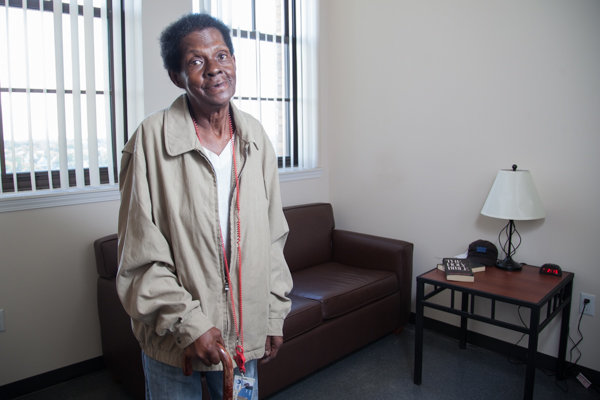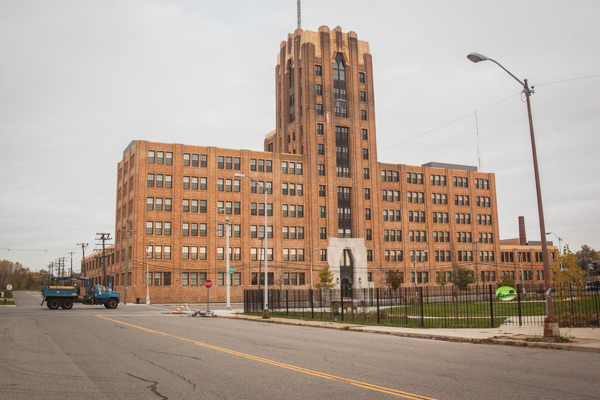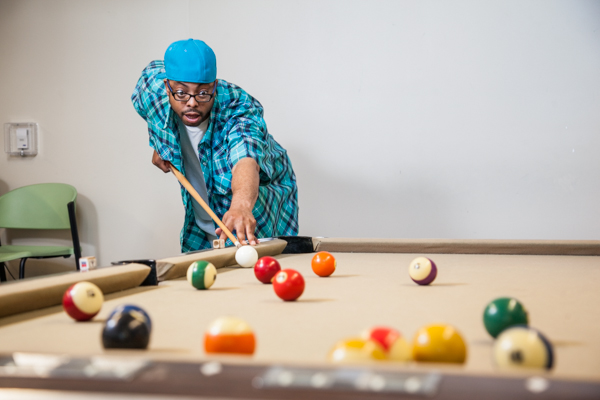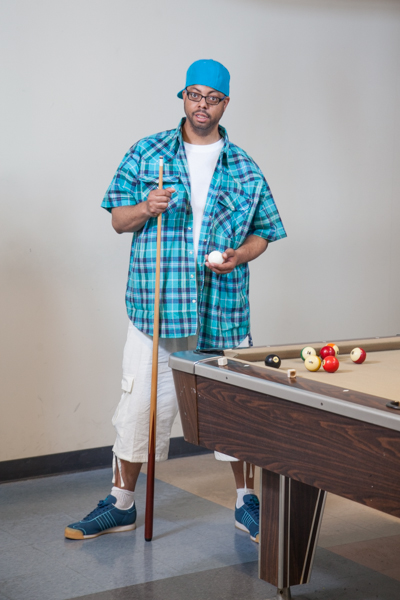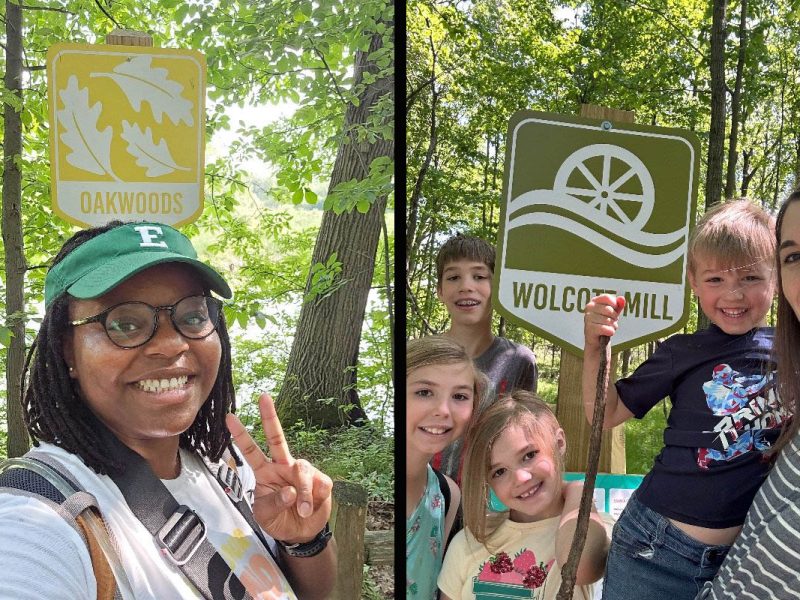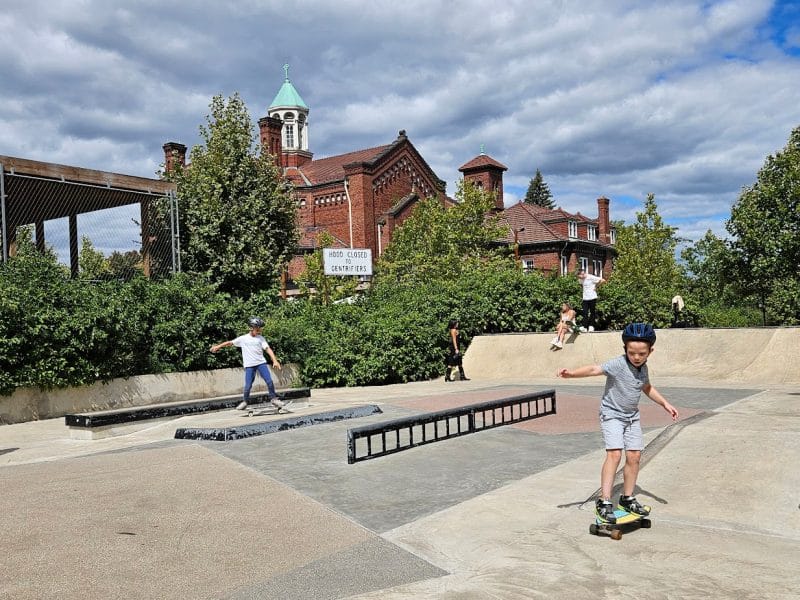Multiple generations of homeless Detroiters find stability in recently rehabbed Bell Building
A unique development in Detroit near Highland Park helps the chronically homeless gain independence and age gracefully on their own terms. Emell Derra Adolphus has this story, the first in our "Aging Together" series, a collaborative project of Model D, MLive Detroit, and WDET.
This is the first feature in our “Aging Together” series, a collaborative project on aging in Detroit between MLive Detroit, WDET 101.9 FM Detroit and Model D.
The celebrated “golden years” of old age sometimes never come for a certain population of Detroiters. They fight a lifelong, internal war with mental disease — an ageless pain that regularly cripples their lives into retirement and steals their minds.
The mentally ill are at highest risk for homelessness in Detroit because many suffer from chronic psychotic episodes. These mental breakdowns stop plans for a future, a family or stability, and can slow life development to the point of stagnation — stranding some with adolescent brains in old bodies.
Virginia Neal, a formerly homeless person, has been suffering from schizophrenia since she was 12 years old.
“When I first started noticing a change in myself, they put me on some kind of medicine. Then I was really hallucinating then,” Neal explains.
Neal became homeless after serving a five-year stint in the infamous Northville Psychiatric Hospital. But she doesn’t think about the past much. At 72, she has finally been granted her independence to age gracefully on her own terms, through the housing first program at the Neighborhood Service Organization‘s (NSO) Bell Building in Detroit near Highland Park.
“You see, I have my own apartment, and I can just stay in there when I am not really sociable,” Neal says. “I can turn my TV on and close my door. And I don’t have to be bothered with anybody.”
Built in 1929, the iconic 255,000 square-foot Bell Building was acquired by the NSO in 2011 with the use of a series of grants. The building was remodeled to accommodate 155 apartments for the chronically homeless and mentally ill, like Neal. NSO uses the housing first approach to battle homelessness — which means to provide housing before mental health needs.
“It’s best if I stay by myself. That way I keep myself out of trouble,” Neal says.
It’s her temper that can be a problem. She even jumped on a policeman once.
“And he was about 6 feet tall!” she says with a grin, clutching her walking cane tighter with a disabled hand. She suffered a fall last winter.
“Other than that, I don’t hardly ever think about anything,” Neal says almost apologetically. “My mind don’t work like that. I thank God every morning I wake up, that’s about the only thing my mind be focused on.” But, she adds: “It’s no fun being homeless.”
In order to live in the Bell Building, tenants must fit what the U.S. Department of Housing in Urban Development classifies as chronically homeless: consecutively homeless for one year or having four bouts of homelessness in the last three years.
When tenants move in to Bell, they receive one completely furnished apartment as a first step in their recovery.
“And then we begin to work on whatever illnesses you may have,” says Tia Cobb, interim unit director at the NSO Bell Building.
Cobb explains that many tenants have “co-occurring illnesses” stemming from attempts to self-medicate through the use of drugs and alcohol.
“That makes it a little bit more difficult to deal with the mental illness piece of it. So we have case managers here that have a background in substance use treatment. Then we have what we call peer support monitors.”
Cobb says homeless people who are actively using substances usually are turned away from local shelters.
“Some of them have been in the service so they have some PTSD (post-traumatic stress disorder). So we meet with you when you first come in and ask what caused you or what you think caused you to become homeless,” Cobb says.
Most of the people applying for Bell Building apartments are recruited from the NSO Tumaini Center — a homeless shelter with no beds, only chairs (one per person) for overnight sleeping. This is where Neal and NSO employee Shane Hardemon, who is also formerly homeless, slept until they qualified for housing. Now Hardemon works to help the population, he says, he will always be part of.
“I tell lots of guys down there just because you see me here and I have a blue shirt on that says ‘NSO,’ doesn’t mean I haven’t been in the same situation you are in,” Hardemon says. “[Mental illness] affects my life 24/7.”
Hardemon was assaulted numerous times and shot twice, driving him into a clinical depression. But he says each day of his mental recovery means giving his son a better father.
“I want him to look at me and be able to say my father has been there for me,” he says. “Knowing that I have a roof over my head, knowing I can reach into my fridge and make something as simple as a bologna sandwich, I see myself getting better and each day is a stepping stone.”
“Living in Detroit and being here all my life,” he adds, “I see different mayors try to change the city, but they are not totally changing it without helping the mentally ill.”
At 37, Hardemon says as he get’s older and his mental health improves, he’s able to also consider his physical and financial health.
“I am trying to maintain myself. Possibly startup a couple of business so I can have money put away for my son. I am thinking future. You have to make sure you are healthy. Get your exercise so you will be able to live to see your future, your family.”
Hardemon is among 17 Bell tenants whose photography work will be featured in an upcoming exhibit at the Bell Building (starting at 4 p.m.) on June 24. Using PhotoVoice research project method, the tenants were asked to identify local factors that negatively affect their health, using cameras.
“We know that people who are homeless experience a lot of health risks. But we don’t have a lot of information about what happens to people who were homeless once they get housed,” explains Becca Cheezum, assistant professor and associate director for the master of public health program at Oakland University. “With the housing first model, the idea is that if we provide housing people can start working on other things. And one of those things that people might work on is their health.”
During their time at Bell, each tenant designs their own plan of recovery, which can include stopping substance use or eating healthier.
“Quality of life is in the eyes of the beholder,” says John Sczomak, assistant unit director of NSO’s Older Adult Services. “For some people, quality of life is being able to live quietly and independently. And you have to respect that. The clients that we serve, they are not looking for the moon and the stars. They want to be independent.”
Sczomak says that older adults tend to feel more stigma about mental illness, and are less likely to seek help. But he says continuous cuts to the city’s general fund negativley affect mental health services and the amount of help available to Detroit’s mentally ill will continue to disappear.
“Only the most extreme services are covered now, which is hospitalization. Your everyday services — your therapy, your medications — they are not covered for people who don’t have insurance,” says Sczomak. “I think it will mean more people in the hospital because they don’t have a stop gap in between. They are going to end up suffering for one thing and the second thing is they are going to end up in the hospital, which is incredibly expensive. And afterwards, without follow up they are going to be in the same boat again.”
Sczomak explains the ultimate goal for anyone suffering from mental illness is independence. “And we often find, to our frustration, it is not given enough creed or credit to how necessary it is.”
Bell resident Jay Thedean, 23, has been chasing independence since he was 3. Originally from North Carolina, he aged out of the state’s foster care system at 18, which included by a brief stay in juvenile detention. He traveled to Detroit to meet a girl, but became homeless when those plans did not work out. Before he became a Bell tenant in 2012, he was couch surfing and also took shelter at the Tumaini Center.
“My parents were unfit parents since the beginning. My father has mental health issues. My mom does to. I am genetically bipolar, unfortunately, along with the gender identity disorder. I had severe PTSD,” he says. “I have multiple diagnoses, I just don’t like to carry them. They are like labels. I hate them.”
Thedean, who also participated in the PhotoVoice project, says seeing what affects other people’s health helped him consider how he will continue to take care of his own.
“Just being here (at the Bell Building) has given me the opportunity to actually grow up to be honest,” Thedean says. “Growing up and trying to fight my identity as being transgender was something that made me go through a lot more than just abandonment issues.”
But his apartment at Bell, says Thedean, now gives him the comforts of stability that everyone deserves to have
“I want to be able to give back,” says Thedean. “Having a mental illness no matter where you are at is difficult. It doesn’t matter what is. You can be bipolar. You can be manic-depressive. You can be schizophrenic. You can have PTSD. It doesn’t matter. Being diagnosed is automatically going to be your main struggle before anything,” he says. “Because at the end of the day, it’s all about your mind.”
Emell Derra Adolphus is a metro Detroit freelance writer and the assistant editor of BLAC Detroit Magazine.
All photos by Marvin Shaouni.
EDITOR’S NOTE: An earlier version of this story misidentified the Bell Building as being located in Highland Park. It is in Detroit.

Aging Together is a summer-long project between MLive Detroit, WDET 101.9FM Detroit and Model D that explores the issues of older adults in Detroit, Southeast Michigan and the state. Follow the series at on Tumblr.
